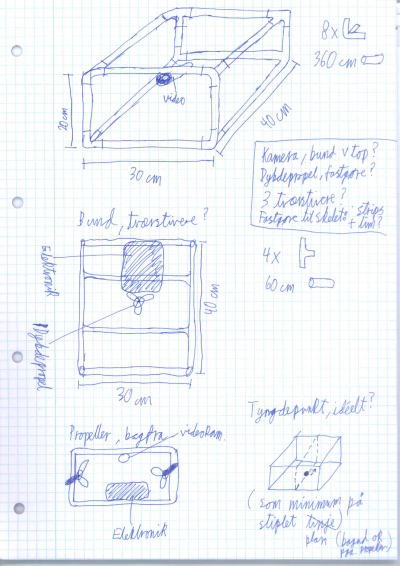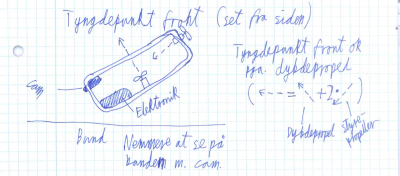Table of Contents
Remote-Controlled Submarine
Inspired by http://blog.xkcd.com/2010/11/05/submarines/ , http://nventivity.com/ROVIAB.html, http://submarineboat.com/rov.htm , http://www.homebuiltrovs.com/
The idea will be to build a skeleton, then add a camera, then add propels and steering. It would also be really cool to add some form of sonar, this can probably extend the range of the underwater “vision”? A depth gauge is almost mandatory, then there should be a switch to make the robot automatically maintain the current depth (using the depth propeller).
Additional features, too cool to think about ATM:
- Robot arm for grapping stuff
- Sonar
- Topology-sonar using webcam and line lasers. Could be used as an crude IMU for attitude determination/navigation, depth-measuring and for scanning the bottom-topology.
- Metal detector/probing stick for determining what something is
- Compressed air-container, allowing release of small amounts of bubbles to indicate position on the surface
- Speaker, to play 8-bit music to the fishes (http://www.youtube.com/watch?v=8pczd4Z9r7c&feature=related)
- Forward thursters ("bilge pumps") for fast forward!
- Harpoon for fish hunting (Technically, the operator will need a fishing license. Food for thought: If we make the robot an autonomous hunter, will the robot need a fishing license?)
People
- Mads Chr. Olesen (mchro)
- Alex Birklykke (Webcam/laser sonar)
The more the merrier; please sign up if you want to help with the project.
Parts list
- Plastic rør (Ø20-30mm ?) + samlinger
- Undervandskamera, vandtæt til 20-30m (se http://www.lh-camerashop.dk/, Vandtæt til 50m, inkl. lys, 3743,75,- )
- Tryk-sikker kasse til elektronik
- 1-200m CAT5 kabel
- 1-200m strømkabel (2 ledere)
- 12v batteri (bilbatteri?)
- Propeller (1 dybdepropel, 2 styrepropeller)
- Microcontroller (Arduino?)
- Vandtæt samling til kabel attach/detach
Propellers
http://www.homebuiltrovs.com/howtobilgeconversion.html
The most common seem to be using bilges and converting to propellers.
http://www.biltema.dk/da/Bad/Pumpe/Lansepumpe/Lansepumpe/
Power budget for needed propellers (32 l/min models):
| Part | Usage (12V) |
|---|---|
| Up motor | 2,5 A |
| Left motor | 2,5 A |
| Right motor | 2,5 A |
Total: 7,5 A
Forward booster (62 l/min): 4 A
Blueprints for shaft converter :http://www.homebuiltrovs.com/howtos/bilgeconversion/bilgeadapter.jpg
We can buy the propels here: http://modelskibet.dk/group.asp?group=28
Motor Control
It is suggested to use a H-bridge configuration with PWM (Pulse Width Modulation) to enable precise control of the thrusters. The H-bridge (L298) is driven by a PWM signal on its EN pins and the direction is controlled via its IN1 and IN2 pins. An Arduino is used as controller together with the small potentiometer-Joystick we have at the hackspace
Components
3A H-bridge L298
www.st.com/stonline/books/pdf/docs/1773.pdf
Schottky Diodes
http://platea.pntic.mec.es/~lmarti2/circuitos/lm2576/1N5822.pdf
5V regulator e.g. 7805 Misc. resistors and capacitors
Camera
Making a cheap submersible camera: http://www.homebuiltrovs.com/howtosimplehousing1.html , http://www.homebuiltrovs.com/howtocamerapotting.html
Maybe using something like http://www.hardware-store.dk/overvagningskamera/spionkamera/prod_3218.html
Deal Extreme http://www.dealextreme.com/p/mini-cmos-surveillance-security-camera-with-30-led-night-vision-dc-12v-42034 or http://www.dealextreme.com/p/waterproof-night-vision-ir-30-led-camera-pal-dc-12v-500ma-15756 or http://www.dealextreme.com/p/professional-cmos-surveillance-security-camera-with-36-led-night-vision-silver-dc-12v-47914
Pressure sensor/Depth Gauge
If target depth is 50m sensor needs to be able to go to ~600 kPa (~100 Psi)
Maybe SPD-100-G-2, e.g. from ELFA.
On Sea Perch they use Arduino as controller and the MXP4250 by Freescale, as presure sensor. We should be able to get two free samples from the webpage of Freescale. It is also available on Elfaelektronik.dk, where then the price is at 130DKK.
UPDATE: We now have a MXP4250GP, thanks to Flemming!
Potential problems
Protecting the electronics
Both from water and from the pressure. One solution is to build a air-tight water-proof box, but then there is the pressure to worry about. Maybe it is easier to coat the PCB's in “lak”, as done by some overclockers when they watercool?
For creating watertight seal, see: http://www.homebuiltrovs.com/howtosealingwireexits.html
Interference on the cable
We will probably run both analog (camerafeed) and digital (steering, comm.) through the same, quite long, cable. Maybe we need to go to CAT6? Or two parallel cables?
Cat 5e STP 50m - 150,- Cat 5e FTP udendørs Netværkskabel 100 meter - 589,-
Lighting
It quickly gets dark underwater, some form of preferably quite strong lighting is required.
Protecting the propellers
Stuff (cable, nastyness, etc.) in propeller = stuck robot. Maybe a form of “gitter” will do, but it might reduce the effect of the rotors as well.
Air in the skeleton pipes
The skeleton pipes should probably be airtight, to not increase the weight of the robot dramatically. This should also give the robot “updrift”.
Preventing rolling
The robot should be kept upright. The standard solution seems to be to have two “pølser” of light material (pvc pipe, plastic foam).
Randall Munroe (xkcd) seems to be doing without.
Work Sketches
Software
Initial design is to have an Arduino controlling the motors onboard, communicate with it over RS485 with a laptop.
Control Software
None yet.
Laptop Software
Initial GUI can be found at Leo at Launchpad. The software is naturally named “Leo”.
Pictures from the building process
:projects:rc-submarine

